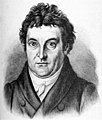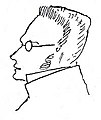Humboldt University of Berlin
The Humboldt University of Berlin (German: Humboldt-Universität zu Berlin, abbreviated HU Berlin) is a public research university in the central borough of Mitte in Berlin, Germany.
"University of Berlin" redirects here. For other uses, see University of Berlin (disambiguation).
The university was established by Frederick William III on the initiative of Wilhelm von Humboldt, Johann Gottlieb Fichte and Friedrich Daniel Ernst Schleiermacher as the University of Berlin (Universität zu Berlin) in 1809, and opened in 1810,[7] making it the oldest of Berlin's four universities. From 1828 until its closure in 1945, it was named Friedrich Wilhelm University (German: Friedrich-Wilhelms-Universität).[8][9] During the Cold War, the university found itself in East Berlin and was de facto split in two when the Free University of Berlin opened in West Berlin. The university received its current name in honour of Alexander and Wilhelm von Humboldt in 1949.[10]
The university is divided into nine faculties including its medical school shared with the Freie Universität Berlin. The university has a student enrollment of around 32,000 students, and offers degree programs in some 189 disciplines from undergraduate to post-doctorate level.[11] Its main campus is located on the Unter den Linden boulevard in central Berlin. The university is known worldwide for pioneering the Humboldtian model of higher education, which has strongly influenced other European and Western universities.[12]
It was generally regarded as the world's preeminent university for the natural sciences during the 19th and early 20th century, as the university is linked to major breakthroughs in physics and other sciences by its professors, such as Albert Einstein.[13] Past and present faculty and notable alumni include 57 Nobel Prize laureates[5] (the most of any German university), as well as scholars and academics including Albert Einstein, Hermann von Helmholtz, Emil du Bois-Reymond, Robert Koch, Theodor Mommsen, Karl Marx, Friedrich Engels, Otto von Bismarck, W. E. B. Du Bois, Arthur Schopenhauer, Georg Wilhelm Friedrich Hegel, Walter Benjamin, Max Weber, Georg Simmel, Karl Liebknecht, Ernst Cassirer, Heinrich Heine, Eduard Fraenkel, Max Planck, Wernher von Braun and the Brothers Grimm.
History[edit]
Main building[edit]
The main building of Humboldt-Universität is the Prinz-Heinrich-Palais (English: Prince Henry's Palace) on Unter den Linden boulevard in the historic centre of Berlin. It was erected from 1748 to 1753 for Prince Henry of Prussia, the brother of Frederick the Great, according to plans by Johann Boumann in Baroque style. In 1809, the former Royal Prussian residence was converted into a university building. Damaged during the Allied bombing in World War II, it was rebuilt from 1949 to 1962.[14]
In 1967, eight statues from the destroyed Potsdam City Palace were placed on the side wings of the university building. Currently there is discussion about returning the statues to the Potsdam City Palace, which was rebuilt as the Landtag of Brandenburg in 2013.[15]








































